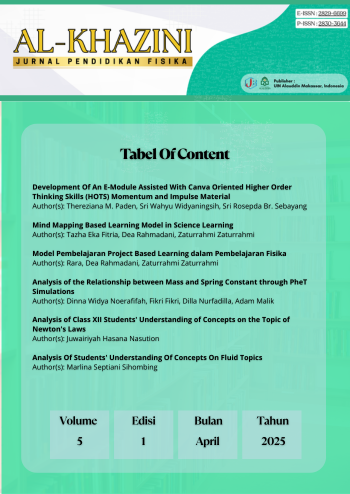Analysis of the Relationship between Mass and Spring Constant through PheT Simulations
DOI:
https://doi.org/10.24252/al-khazini.v5i1.43942Keywords:
Energi Potensial , Pegas, Gaya BeratAbstract
Springs can be found in various shapes and sizes depending on the application. Springs can be used to store energy, maintain position or dampen vibrations, and also to produce the necessary force in mechanical systems. This research was carried out using a virtual lab based on phet simulations. Phet simulations are simulations that can be used by teachers in teaching fraction material in class. The method used in this research uses a quantitative method by processing practical statistical data virtually. The data can be measured and calculated directly and the explanation is expressed in numbers or figures. The technique used in collecting data is by carrying out several experiments and entering different variable values. From this research, the results obtained are that gravity has a directly proportional relationship to the amount of potential energy of the spring. The greater the weight force acting on the spring system, the greater the potential energy of the spring.
Downloads
References
Budiman, A., Faturahman, Nugroho, D. A., Nurzaki, A. Z., Rahmawati, D., Latifah, A. L., & Malik, A. (2023). Analisis Pengaruh Konstanta Pegas terhadap Pertambahan Panjang Pegas. JURNAL ILMU FISIKA DAN TERAPANNYA, 10(01), 12–30.
Refiantoro, R. F., & Kurmiawanti. (2022). Penentuan Konstanta Pegas dalam Hukum Hooke pada Rangkaian Tunggal, Seri dan Paralel. JIE.UPY :Journal of Industrial Engineering Universitas PGRI Yogyakarta, 1(2), 53–59.
Taayun, H. Q., & Malik, A. (2023). Pengaruh Massa Pada Beban Terhadap Konstanta Pegas. AL-KHAZINI, 3(2), 105–122. https://doi.org/10.24252/al-khazini.v3i2.39323
Yakin, Y. A., Pratiwi, D. S., & Bilaldy, B. F. (2020). Analisis Konstanta Pegas pada Fondasi Tiang (Studi Kasus: Gedung Type B DPRD Surabaya). RekaRacana: Jurnal Teknil Sipil, 6(1), 42. https://doi.org/10.26760/rekaracana.v6i1.42
Rusianto, T., & Susastriawan, A. A. P. (2021). Getaran Mekanis.
Ewar, H. A., Bahagia, M. E., Jeluna, V., Astro, R. B., & Nasar, A. (2021). PENENTUAN KONSTANTA PEGAS MENGGUNAKAN APLIKASI PHYPHOX PADA PERISTIWA OSILASI PEGAS. Jurnal Kumparan Fisika, 4(3), 155–162. https://doi.org/10.33369/jkf.4.3.155-162
Fauzi, M. R., Risha, N., Gunadi, I. G. A., & Yasmini, L. P. B. (2021, October). KOEFISIEN ELASTISITAS VIRUS HIV-1 MATURE. In SEMINAR NASIONAL 2021 (p. 1)
Gunawidjaja, P. N. (2019). Pengembangan Metode Eksperimen Fisika Berbasis Komputer pada Topik Kinematika Gerak Pegas. Jurnal Penelitian Pembelajaran Fisika, 10(2), 119-126.
Hanisah, S. (2021). Hubungan Kesadaran Metakognitif dengan Hasil Belajar Peserta Didik pada Materi Elastisitas dan Hukum Hooke di SMA Negeri 1 Rundeng (Doctoral dissertation, UIN Ar-raniry).
Harja, M. (2019). Penggunaan Pembelajaran Kooperatif Tipe STAD Untuk Meningkatkan Hasil Belajar Peserta Didik Pada Materi Elastisitas Dan Hukum Hooke Di Kelas XI MAN 2 Aceh Selatan (Doctoral dissertation, UIN Ar-Raniry Banda Aceh).
Hia, S., & Panuluh, A. (2021). Pengukuran Modulus Geser Baja Menggunakan Analisis Osilasi Pegas-Massa dengan Software Logger Pro. Jurnal Teori Dan Aplikasi Fisika, Vol.09, No.1.
Hidayatulloh, A. (2020). Analisis kesulitan belajar fisika materi elastisitas dan hukum hooke dalam penyelesaian soal–soal fisika. Kappa Journal, 4(1), 69-75.
Downloads
Published
How to Cite
Issue
Section
License
Copyright (c) 2025 Dinna Widya Noerafifah, Fikri Fikri, Dilla Nurfadilla, Adam Malik

This work is licensed under a Creative Commons Attribution-NonCommercial 4.0 International License.
The Authors submitting a manuscript do so on the understanding that if accepted Al-Khazini:Jurnal Pendidikan Fisika for publication, copyright publishing of the article shall be assigned/transferred to Physics Education Department, UIN Alauddin Makassar as Publisher of the journal. Upon acceptance of an article, authors will be asked to complete a 'Copyright Transfer Agreement'. An e-mail will be sent to the corresponding author confirming receipt of the manuscript together with a 'Copyright Transfer Agreement' form by the online version of this agreement.
Al-Khazini:Jurnal Pendidikan Fisika and Physics Education Department, UIN Alauddin Makassar, , and Physics Society of Indonesia as the Editors and the Advisory International Editorial Board make every effort to ensure that no wrong or misleading data, opinions or statements be published in the journal. In any way, the contents of the articles and advertisements published in the Al-Khazini:Jurnal Pendidikan Fisika are the sole and exclusive responsibility of their respective authors and advertisers.
The copyright form should be signed electronically and send to the Editorial Office in the form of the original e-mail: [email protected]



















